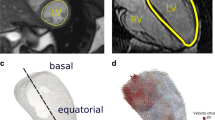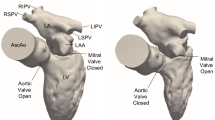Abstract
A combined computational fluid dynamics (CFD) and magnetic resonance imaging (MRI) methodology has been developed to simulate blood flow in heart chambers, with specific application in the present study to the human left ventricle. The proposed framework employs MRI scans of a human heart to obtain geometric data, which are then used for the CFD simulations. These latter are accomplished by geometrical modeling of the ventricle using time-resolved anatomical slices of the ventricular geometry and imposition of inflow/outflow conditions at orifices notionally representing the mitral and aortic valves. The predicted flow structure evolution and physiologically relevant flow characteristics were examined and compared to existing information. The CFD model convincingly captures the three-dimensional contraction and expansion phases of endocardial motion in the left ventricle, allowing simulation of dominant flow features, such as the vortices and swirling structures. These results were qualitatively consistent with previous physiological and clinical experiments on in vivo ventricular chambers, but the accuracy of the simulated velocities was limited largely by the anatomical shortcomings in the valve region. The study also indicated areas in which the methodology requires improvement and extension. © 2001 Biomedical Engineering Society.
PAC01: 8719Hh, 4711+j, 8761Lh, 8719Uv
Similar content being viewed by others
References
Ehman, R. L., and J. P. Felmlee. Adaptive technique for high-definition MR imaging of moving structures. Radiology173:255–263, 1989.
Engeln-MÜllges, G., and F. Uhlig. Numerical Algorithms with Fortran. New York: Springer, 1996.
Ferziger, J. H., and M. PeriĆ. Computational Methods for Fluid Dynamics. Berlin: Springer, 1997.
Gorodkov, A., N. B. Dobrova, J. P. Dubernard, G. I. Kiknadze, I. A. Gatchetchiladze, V. G. Olienikov, N. B. Kuzmina, J. L. Barat, and C. Baquey. Anatomical structures determining blood flow in the heart left ventricle. J. Mater. Sci.7:153–160, 1996.
Issa, R. I.Solution of implicitly discretized fluid flow equations by operator splitting. J. Comput. Phys.62:40–65, 1986.
Jones, T. N., and D. N. Metaxas. Patient-specific analysis of left ventricular blood flow. In: Proceedings of MICCAI '98. Heidelberg: Springer LNCS, 1998.
Kilner, P. J., G.-Z. Yang, R. H. Mohiaddin, D. N. Firmin, and M. H. Yacoub. Asymmetric redirection of flow through the heart. Nature (London)404:759–761, 2000.
Kim, W. Y., P. G. Walker, E. M. Pederson, J. K. Poulsen, S. Oyre, K. Houlind, and A. P. Yoganathan. Left ventricular blood flow patterns in normal subjects: a quantitative analysis by three-dimensional magnetic resonance velocity mapping. J. Am. Coll. Cardiol.26:224–238, 1995.
Levick, J. R. An Introduction to Cardiovascular Physiology, 2nd ed. Oxford: Butterworth-Heinemann, 1995.
Long, Q., X. Y. Xu, M. W. Collins, T. M. Griffith, and M. Bourne. The combination of magnetic resonance angiography and computational fluid dynamics: a critical review. Crit. Rev. Biomed. Eng.26:227–274, 1998.
Lorenz, C. H., E. S. Walker, V. L. Morgan, S. S. Klein, and T. P. Graham, Jr.Normal human right and left ventricular mass, systolic function, and gender differences by cine magnetic resonance imaging. J. Cardiovasc. Magn. Reson.1:7–21, 1999.
Moore, J. A., B. K. Rutt, S. J. Karlik, K. Yin, and C. R. Ethier. Computational blood flow modelling based on in vivo measurements. Ann. Biomed. Eng.27:627–640, 1999.
Osman, N. F., W. S. Kerwin, E. R. McVeigh, and J. L. Prince. Cardiac motion tracking using CINE harmonic phase (HARP) magnetic resonance imaging. Magn. Reson. Med.42:1048–1060, 1999.
Park, J., D. Metaxas, A. A. Young, and L. Axel. Deformable models with parameter functions for cardiac motion analysis from tagged MRI data. IEEE Trans. Med. Imaging15:278–289, 1996.
Pasipoularides, A.Clinical assessment of ventricular ejection dynamics with and without outflow obstruction. J. Am. Coll. Cardiol.15:859–882, 1990.
Peskin, C. S., and D. M. McQueen. A three-dimensional computational method for blood flow in the heart-I. Immersed elastic fibers in a viscous incompressible flow. J. Comput. Phys.81:372–405, 1989.
Steinman, D. A., R. Frayne, X. D. Zhang, B. K. Rutt, and C. R. Ethier. MR measurement and numerical simulation of steady flow in an end-to-side anastomosis model. J. Biomech.29:537–542, 1996.
Stuber, M., S. E. Fischer, M. B. Scheidegger, and P. Boesiger. Slice following in cardiac imaging with optimized rf pulse-angles. In 12th Annual Conference of the Society of Magnetic Resonance in Medicine, New York, August 1993, p. 418.
Stuber, M., E. Nagel, S. E. Fischer, M. A. Spiegel, M. B. Scheidegger, and P. Boesiger. Quantification of the local heart wall motion by magnetic resonance myocardial tagging. Comput. Med. Imaging Graphics22:217–228, 1998.
Taylor, C. A. A computational framework for investigating hemodynamic factors in vascular adaptation and disease. Thesis, Stanford University, 1996.
Taylor, T. W., H. Suga, Y. Goto, H. Okino, and T. Yamaguchi. The effects of cardiac infarction on realistic three-dimensional left ventricular blood ejection. J. Biomech. Eng.118:106–110, 1996.
Van Leer, B.Towards the ultimate conservative difference scheme V: A second-order sequel to Godunov's method. J. Comput. Phys.32:361–370, 1979.
Weston, S. J., N. B. Wood, G. Tabor, A. D. Gosman, and D. N. Firmin. Combined MRI and CFD analysis of fully developed steady and pulsatile laminar flow through a bend. J. Magn. Reson. Imaging8:1158–1171, 1998.
Wood, N. B.Aspects of fluid dynamics applied to the larger arteries. J. Theor. Biol.199:137–161, 1999).
Yellin, E. L., S. Nikolic, and R. W. M. Frater. Left ventricular filling dynamics and diastolic function. Prog. Cardiovasc. Diseases32:247–271, 1990.
Young, A. A., and L. Axel. Three-dimensional motion and deformation of the heart wall: estimation with spatial modulation of magnetization—A model-based approach. Radiology185:241–247, 1992.
Author information
Authors and Affiliations
Rights and permissions
About this article
Cite this article
Saber, N.R., Gosman, A.D., Wood, N.B. et al. Computational Flow Modeling of the Left Ventricle Based on In Vivo MRI Data: Initial Experience. Annals of Biomedical Engineering 29, 275–283 (2001). https://doi.org/10.1114/1.1359452
Issue Date:
DOI: https://doi.org/10.1114/1.1359452




